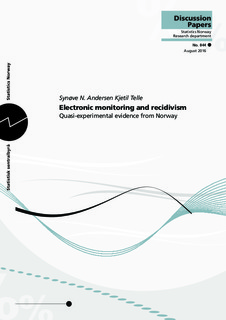| dc.contributor.author | Andersen, Synøve Nygaard | |
| dc.contributor.author | Telle, Kjetil | |
| dc.date.accessioned | 2018-09-11T08:59:10Z | |
| dc.date.available | 2018-09-11T08:59:10Z | |
| dc.date.issued | 2016-08-26 | |
| dc.identifier.issn | 1892-753X | |
| dc.identifier.uri | http://hdl.handle.net/11250/2561930 | |
| dc.description.abstract | The replacement of custodial with non-custodial sanctions holds the potential to reduce recidivism as well as other costs associated with imprisonment.
However, the causal impacts on recidivism of non-custodial sanctions in general, and electronic monitoring (EM) programs in particular, remain unclear. We estimate the effect of EM on recidivism by exploiting an EM program that was gradually introduced in Norwegian counties from 2008, using difference-in-differences and instrumental variable designs. Results show that introducing EM reduced 2-year recidivism rates by about 10 percent, which corresponds to about 19 percent for those actually serving on EM. We find no effects on recidivism intensity or severity. Subsample analyses show that the effect estimates are strongest among offenders without previous imprisonment or recent unemployment spells, and although between-groups differences are statistically non-significant, this suggest that avoiding prison stigma and maintaining workplace relations can be important to reduce recidivism and promote desistance. The reliability of our results is somewhat challenged by unstable pre-implementation trends and signs that more people are convicted to EM-qualifying sentences when EM is introduced. | nb_NO |
| dc.language.iso | eng | nb_NO |
| dc.publisher | Statistisk sentralbyrå | nb_NO |
| dc.relation.ispartofseries | Discussion Papers;No. 844 | |
| dc.subject | Kriminalomsorg | nb_NO |
| dc.title | Electronic monitoring and recidivism. Quasi-experimental evidence from Norway | nb_NO |
| dc.type | Working paper | nb_NO |
| dc.subject.nsi | VDP::Samfunnsvitenskap: 200::Kriminologi: 350 | nb_NO |
| dc.source.pagenumber | 55 s. | nb_NO |
